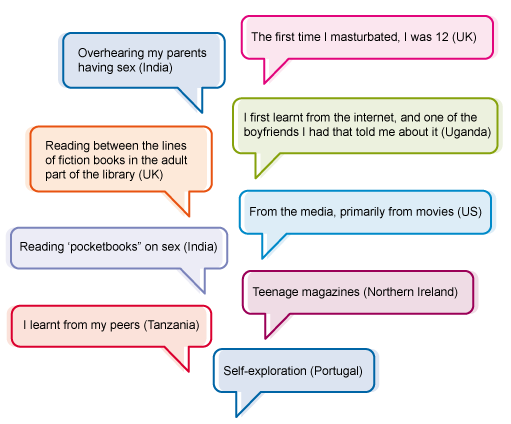Use 'Print preview' to check the number of pages and printer settings.
Print functionality varies between browsers.
Printable page generated Thursday, 20 November 2025, 4:43 PM
Learning Session 2: Why is it important to talk about pleasure?
Introduction
In the first learning session, you learnt about the different ways we talk about sex, and in particular, the difference between risk-based and positive approaches to discussing sex.
But why is it important to talk about sexual pleasure with young people? What are the benefits of taking a positive approach? And, if we don’t talk to young people about sexual pleasure, where else can they go to learn about it? We cover all these questions and at the end of this session you should:
- understand the benefits of including sexual pleasure as part of Comprehensive Sexuality Education (CSE)
- recognise that sexual pleasure is a fundamental aspect of all people’s quality of life/health and well-being
- have considered the many different messages about sexual pleasure that young people encounter in their day-to-day lives.
2.1 Where do people hear about sexual pleasure?
As adults it’s often hard for us to remember where we first got the idea that sex might be about more than just having babies – that it can also be fun! Thinking back on our own experience can help us think about the different ways young people learn about sexual pleasure.
Activity 2.1: Can you remember where you first learnt about sexual pleasure?
Take a few minutes to answer the question in the text box below .
Discussion
Here are a few real-life examples from others who responded to this question. Think about how your answers compare to these examples .
There are many places young people learn about sex: from parents, at school/college, by discussing it with friends, and from the media, etc. It’s really important that young people understand that sex can and should be pleasurable, but often the messages they receive are not backed up by practical information and do not offer support or discussion.
In more formal settings (such as at school/college, or at home with parents) the messages are not wholly positive, and may be mixed, causing young people to feel confused or even stigmatised when discussing the subject of sexual pleasure. Even sexuality education classes may make some young people feel shy about opening up about their questions and experiences around sex.
And, if the subject is covered in a biology class, the focus on the anatomical, physical aspects of sex often fails to address the reality of young people’s actual sexual experiences.
We need to create safe spaces to discuss things like relationships, romance, lust, flirtation and consent, making sure the information we give is direct, clear and accurate.
Further thoughts
Young people want to know about pleasure!
One study of over a thousand young people in New Zealand showed that, when asked to write a question for a sex and relationships expert, 58% of the questions related to pleasure. Building pleasure into your education sessions will make them more engaging and relevant (Allen, 2008).
2.2 Risk-based versus positive refresh
Here’s a chance to refresh your memory about the risk-based versus positive approaches to sexuality education we looked at in Learning session 1.
Activity 2.2: Refresher on risk-based versus positive approaches
Take a look at the three pictures and their captions below, and in the text box below each one jot down a line or two about what the picture and caption suggests to you about risk-based approaches.
2.3 The sexual pleasure time machine
We’re now going to jump backwards and then forwards in time to imagine what might happen to people if they don’t get an opportunity to talk about sexual pleasure as part of their sexuality education.
What can happen if we only learn about the biological aspects of sexuality and reproduction?
Activity 2.3: The sexual pleasure time machine
Choose two of the case studies below and read their stories. Then consider how things might have been different for each story.
These three case studies help us think about what we leave out when we present sex only as something to avoid until we want to have babies. Without acknowledging that sex can and should be a pleasurable act, not just a pregnancy or STI risk, we ignore:
our deeper understanding of communication and consent: knowing what we do and don’t like and feeling empowered enough to communicate this.
- those who may be in same-sex relationships who often feel excluded from sexuality education, which prioritises sex as a means for having babies.
- conversations about gender and power and links to coercive relationships. If someone doesn’t know what a positive, pleasurable sexual relationship looks like, it might be difficult for them to recognise abusive behaviour.
- linking pleasure to condoms and contraception: understanding that there are ways to share pleasure that have lower risk than vaginal or anal intercourse and that condom use can be sexy! Feeling protected during sex may improve people’s enjoyment and ability to relax.
- real-world messages that young people get about sex which may contradict what they are being told by parents or in school.
2.4 Sexual pleasure and disability
Around 15% of the world's population lives with some form of disability. This might be a physical disability, or one which affects someone’s mental health/learning ability. Not all disabilities are visible. Often, people with disabilities find that their sexuality is ignored, neglected or stigmatised by society.
You are now going to watch a documentary about women in India living with disabilities which shows why it’s important to include pleasure in CSE. It’s a really great video, and you could watch it all the way through if you have time, but for the purposes of this activity we’re going to focus on two clips.
Activity 2.4: Sexual pleasure and disability
2.5 What does the media tell us about sex?
As an educator it can be useful to keep an eye on the kinds of media that young people in your community may be seeing. Talking about different media is often a good way of including discussion about sexual pleasure in your work with young people. Keeping up to date with the media is also essential for helping young people to navigate the often confusing messages they are receiving about their sexual desire, rights and health.
We are bombarded with messages about gender roles and sexuality, sometimes without even realising it. In order to help young people understand the messages they receive from the media today, it’s important that you have a good understanding of what the media is saying about what’s ‘normal’ or ‘expected’.
Activity 2.5: What does the media tell us about sex?
Discussion
This is a useful way to start to think about how we can create relatable education programmes which help young people better understand the messages they are receiving about sexuality, and that support them to challenge ‘norms’ and stereotypes around gender and sexuality which may not be realistic.
Conclusion
In this learning session, you learnt about the benefits of including sexual pleasure as part of Comprehensive Sexuality Education (CSE). You also learnt about how important it is to provide a learning environment which includes an open, honest and wide-ranging discussion of pleasure. This can be a great place to ensure questions can be welcomed and answered accurately and sensitively.
In most societies, constructive discussion of sexual pleasure aimed at young people is not encouraged. This really constitutes a denial of their sexuality, and indeed, their sexual rights. Moreover, not openly and fully talking about sexual pleasure often means that young people are ill equipped to deal with all the possibilities and opportunities in their sexual futures.
In this learning session, you learnt that it is important to recognise that sexual pleasure is a fundamental aspect of all people’s quality of life/health and well-being.
Finally, in this learning session, you should have considered the many different messages about sexual pleasure that young people encounter in their day-to-day lives. Young people get messages about sexual pleasure from different places and at different ages. These do not necessarily provide accurate information or follow-up support.
In the next learning session, we move on to talk about how and why so many educators find it hard to integrate sexual pleasure into the work they do with young people.
Now you can go to Learning Session 3.




